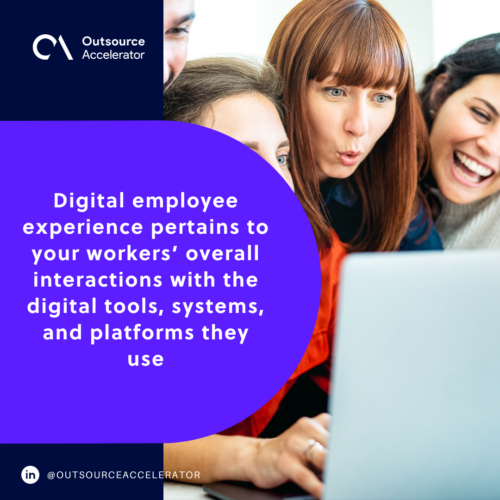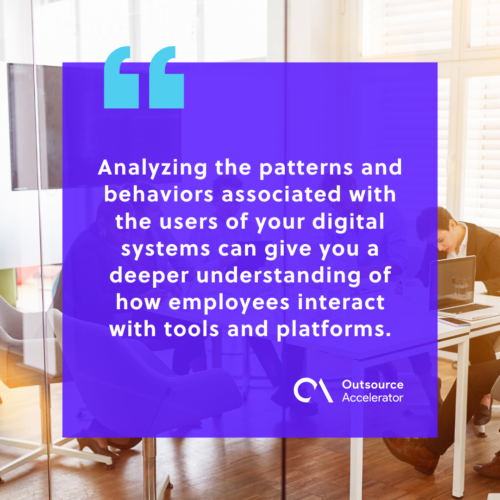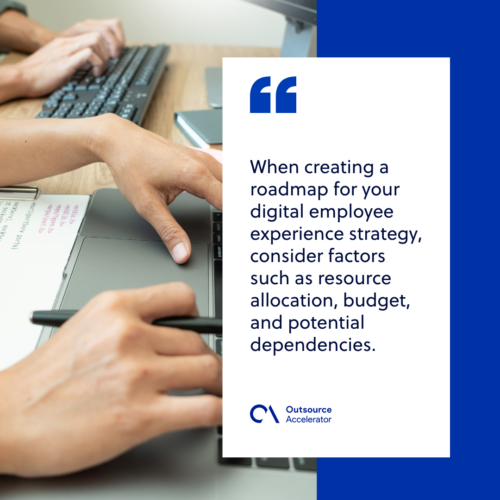Optimizing digital employee experience for improved employee productivity and engagement

As businesses evolve and realize employee engagement’s importance – even in remote work setups – companies have begun to focus on digital employee experience (DEX).
Many enterprises have taken steps to improve their workers’ digital employee experience to enhance productivity and engagement.
It’s important to remember that your employees’ digital employee experience goes beyond merely providing them with the tools they need to work.
Rather, the overall interactions, interfaces, and workflows they encounter in their workspace comprise the whole digital employee experience.
A well-designed and user-centric digital employee experience can significantly impact your workers’ job satisfaction and overall performance. Poor digital employee experience can lead to a decline in your employees’ effectiveness and performance levels.
Read on below to learn more about the digital employee experience and how you can optimize it!
Understanding digital employee experience
Before delving into how to improve your company’s digital employee experience, you must first have a clear understanding of what DEX is.
As stated earlier, digital employee experience pertains to your workers’ overall interactions with the digital tools, systems, and platforms they use.
Digital employee experience encompasses everything from the user interface and accessibility to communication channels and personalization options.
It refers to your employees’ perception of everything from their work computers and the software and programs they use to your company’s entire IT infrastructure.
Key elements of a positive digital employee experience
Businesses that want to optimize their digital employee experience need to consider several key concepts that contribute to it.
These concepts serve as the foundation of an excellent digital employee experience.
User-friendly interfaces
User-friendly interfaces are among the most critical elements of a positive digital employee experience. Your workers should be able to navigate their digital tools and systems easily, find the information they need quickly, and perform their tasks efficiently.
Ensure your company’s digital infrastructure uses intuitive design principles, clear labeling, and logical information architecture.
Seamless integration
Your employees will use multiple tools and systems when doing their job.
This presents you with another way of ensuring they get a positive digital employee experience through the seamless integrations of the tools and systems they use. It removes the need for your workers to keep switching between different platforms and re-enter information repeatedly.
Integrating communication tools, project management systems, and other relevant platforms will give your employees a cohesive and efficient digital employee experience.
Reliable and secure infrastructure
Another way of ensuring your employees get a great digital employee experience is by providing them with a robust and secure digital infrastructure.
Downtime, system failures, or data breaches can severely impact employee productivity. Investing in reliable hardware, software, and a powerful IT infrastructure gives your workers a stable and secure digital environment.
You can create a reliable digital infrastructure through regular maintenance, updates, and data backup protocols
Accessible communication channels
Effective communication is a cornerstone of collaboration and engagement within organizations. It is also among the essentials for creating a positive digital employee experience.
Provide your employees with various communication options like email, live chats, video conferencing, and collaboration tools. These communication channels should be easily accessible and have user-friendly interfaces.
Personalization and customization
Letting your employees tailor their digital workspace according to their preferences and work requirements can empower them.
Allowing them to personalize the interfaces they use (e.g., letting them choose relevant widgets and tools) can significantly improve their digital employee experience.
The sense of ownership and control this imparts can greatly increase their productivity and engagement.

How to assess your company’s digital employee experience
Assessing your company’s current digital employee experience is a crucial step in the optimization process. By understanding the strengths and weaknesses of your existing digital environment, you can identify areas for improvement.
A thorough understanding of the state of your digital employee experience helps you make informed decisions and implement targeted strategies to enhance productivity and engagement.
Below are some steps you can follow to assess your organization’s DEX:
Employee survey and feedback
Conducting surveys and gathering feedback from your employees is an effective way to assess their digital experience. To do this, you can design surveys that inquire about their satisfaction levels, pain points, and suggestions for improvement.
The data collected from these surveys can give valuable insights into areas requiring attention.
Usage patterns and user behavior analysis
Analyzing the patterns and behaviors associated with the users of your digital systems can give you a deeper understanding of how employees interact with tools and platforms.
You can monitor metrics such as logins, active users, task completion rates, and frequency of tool usage. Doing so can help reveal areas your employees may be facing difficulties or experiencing inefficiencies.
Usability testing
Usability testing involves observing employees perform specific tasks using digital tools and systems. This approach allows you to identify any usability issues, bottlenecks, or areas of confusion.
Conducting usability testing with representative employees can help you uncover hidden problems and gain insights for improvement.

Challenges in implementing digital employee experience strategies
Implementing an effective digital employee experience strategy comes with its own set of challenges. Being aware of these obstacles can help you proactively address them.
That said, below are potential hurdles you can face when implementing digital employee experience strategies:
Resistance to change
Introducing new digital tools or processes can be met with resistance from employees accustomed to existing systems.
However, you can overcome this challenge by:
- Providing proper training
- Communicating the benefits of these digital tools
- Involving your employees in the decision-making process
When your efforts to implement new processes and technologies are met with resistance, address your workers’ concerns. You can demonstrate how these tools can improve their digital employee experience.
Legacy systems and infrastructure
Businesses running on legacy systems and outdated infrastructure can have difficulty implementing a seamless digital employee experience.
One reason is legacy systems may lack the necessary integrations or modern capabilities for an optimized digital environment.
To circumvent this, companies must identify areas requiring modernization, invest in necessary upgrades, and develop a migration plan to ensure a smooth transition.
Lack of awareness and support
Whether or not your digital employee experience strategy will succeed relies on overall organizational support and awareness.
Leadership buy-in, adequate resources, and ongoing stakeholder support are vital for implementing and maintaining a positive digital employee experience.
You can gain support from your organization by effectively communicating the vision, benefits, and expected outcomes of your digital employee experience strategy.
Steps in implementing an effective digital employee experience strategy
Having discussed the obstacles you can potentially encounter when implementing a digital employee experience strategy, it’s time to learn how to implement it.
Follow the steps below to implement an effective digital employee experience strategy:
Define goals and objectives
The first step to creating an effective digital employee experience strategy is clearly defining the goals and objectives you want to achieve. Identify the specific outcomes you aim to accomplish (e.g., increased productivity, improved collaboration, enhanced employee satisfaction).
These goals will guide your strategy and ensure alignment with the overall business objectives of your company.
Develop a roadmap
Once you have identified your digital employee experience strategy’s goals and objectives, you can begin developing a roadmap.
The roadmap must outline the implementation plan for enhancing the digital employee experience of your workforce.
Prioritize areas for improvement based on the assessment phase, identify the tools and technologies required, and define the timeline for each implementation phase.
When creating a roadmap for your digital employee experience strategy, consider factors such as resource allocation, budget, and potential dependencies.
Engage employees
Let your employees be involved in the process from the beginning. Seek their input, involve them in decision-making, and provide training and support throughout the transition.
Actively communicate the benefits of the optimized digital employee experience, address their concerns, and create a sense of ownership and empowerment.
Continuously monitor and improve
Implementing an effective digital employee experience strategy is not a one-and-done process but an ongoing one.
You will need to monitor your initiatives’ impact and gather employee feedback regularly to maintain an optimized level of digital employee experience.
You can use analytics tools, employee surveys, and usage metrics to track the success of your optimization efforts. You can then incorporate this feedback and make necessary adjustments to improve the digital employee experience continually.

Why an optimized digital employee experience matters
Optimizing your workers’ digital employee experience is crucial for improving their productivity and engagement.
A positive digital employee experience serves as one of the foundations for employee productivity, engagement, and overall satisfaction.
Because it directly affects your workers’ productivity and job satisfaction, improving their digital employee experience also positively impacts your company’s bottom line.







 Independent
Independent




